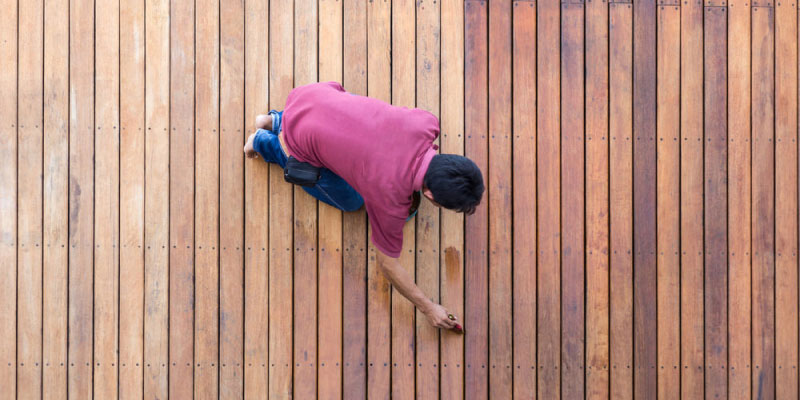
3 Easy Step-By-Step DIY Deck Projects
|
|
Time to read 4 min
|
|
Time to read 4 min
Check to see if the stains are caused by mold. Decks that spend large parts of the day in the shade or that get wet often can develop mold. Use a small amount of bleach on one of the discolored spots. If the bleach dissolves the spot, cleaning your deck with a soft bristle brush and the right cleanser will remove discoloration. For composite decking, soapy water is all you need. For wood, mix warm water and bleach in a 4-1 ratio.
If the discoloration problem coats a large part of your deck, a power washer can take care of the problem in a matter of minutes. Power washing the deck will remove mold and mildew discoloration and strip off the dirt that becomes ingrained in the wood. Enjoy a fresher deck color that’ll be easier to stain or paint after power washing.
Tip: If the power washer misses certain stubborn spots, scrubbing those areas by hand can help address problem areas.
Discoloration sometimes occurs because your old stain wears off unevenly. Don’t paint over the old stain without sanding or stripping it off. Otherwise, you’ll face a patchy deck with uneven color. Start by removing the discolored stain with a paint stripper. Then, use stain remover to take the remaining stain off the deck. If you have any stubborn spots, you may have to sand away the stain. Once you’ve removed the old stain, you’re ready to repaint.
Sometimes, your deck boards become loose because they’ve warped over time. When boards become warped or curled, you don’t always need to cut them out and replace them. Before taking that complicated route, try straightening the existing boards first. Start by removing the screws or nails that hold the board in place so that you can pull it from the deck.
If the warping is minor, you can reattach the same board. Place the screws through different parts of the wood. This adjustment changes the tension on the board and will often fix the warping issue.
Tip: If nails originally fastened your deck boards, use wood screws when you make repairs. Wood screws are less likely to slip out of place and prevent boards from curling in the future.
For a small deck, rollers and brushes will work well. While you’re painting, coat two to three boards at a time using long strokes. Always brush wet portions of paint into wet portions of paint to prevent any brush marks from showing as the paint dries. Larger decks will require using a pump-style sprayer to save time. You can rent one at a hardware store or rental center. Make sure to cover nearby exterior walls with drop cloths so that you don’t spray the side of your home.
Tip: Sometimes stain clogs in the nozzle of a paint sprayer. Dilute the stain slightly if you experience this problem.
Add basic deck repair to your list of home maintenance tasks. Even if you’re uncomfortable around power tools, the deck repairs presented above are simple enough that most homeowners can get a good result.